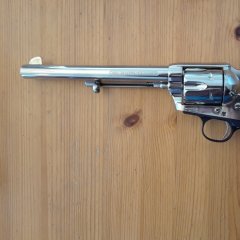-
Posts
4,215 -
Joined
-
Last visited
-
Days Won
1
Content Type
Profiles
Forums
Events
Everything posted by Tex Jones, SASS 2263
-

Car Shield, Endurance etc.
Tex Jones, SASS 2263 replied to Rye Miles #13621's topic in SASS Wire Saloon
The same as home warranty outfits. Depends on what you pay for. Also, depends on who (mechanic, electrician, plumber, etc.) will accept the warranty outfit's payments, which are discounted. The idea being that the warranty outfit can direct business to the service provider. I had a home warranty account for a year when I purchased my current home. There were a couple of times that I could not find any of the warranty company's preferred service providers and the company finally allowed me to find my own. -

Favorite start line for hot weather?
Tex Jones, SASS 2263 replied to Possum Skinner, SASS#60697's topic in SASS Wire
"Let's get this over with!" -
Best bet is to call them: 800 784 4331
-
Your location according to SASS is New York. Best to change your profile information.
-

Winchester/miruko parts
Tex Jones, SASS 2263 replied to Sheriff Dill's topic in SASS Wire Classifieds
Shotgun Boogie imports their parts. -

Winchester/miruko parts
Tex Jones, SASS 2263 replied to Sheriff Dill's topic in SASS Wire Classifieds
None available. The only parts available are the springs, which are shown on Shotgun Boogies' website. Those are aftermarket parts. Winchester does not supply parts. -
Even though SWC type bullets are problematic in a rifle, they can be used in the pistols. Recoil may be more than you want; don't throw them away. Which clubs re near you? Plenty of knowledgeable shooters at Boot Hill Regulators and Circle K Regulators, among others who can help you out.
-
Lots of guns for sure.
-
Sorry to learn of your friend's passing. That's a loss. Condolences to the family.
-
Local Scheels and Fleet Farm took primers off the shelves a couple of years ago. Scheels has put them back, but not Fleet Farm.
-
When I rode as a kid we didn't use stirrups, many times didn't use a saddle, either.
-

New Puppy has fitted in well
Tex Jones, SASS 2263 replied to Buckshot Bear's topic in SASS Wire Saloon
Nice addition to the family. You're outnumbered. -

MA/CT/RI Tri-State in ME this weekend!
Tex Jones, SASS 2263 replied to H. K. Uriah, SASS #74619's topic in SASS Wire
Is there a list of shooters? -
Job is looking good.
-

IT WAS THE 3rd of JUNE........
Tex Jones, SASS 2263 replied to No Horse Hair, SASS #77464's topic in SASS Wire Saloon
I was out chopping cotton and my brother was baling hay..... -

Colt 1849 Restoration Work?
Tex Jones, SASS 2263 replied to H. K. Uriah, SASS #74619's topic in SASS Wire
Turnbull could do it. Bill Fuchs, owner of Spring Creek Armory does restoration work. I haven't sent anything to him, but others have and they have been pleased with the results. Tel. No: 307 431 9194. Web site: springcreekarmory.com. -
I had that happen in a former home. Water ran from the back to the front on a slope. I dug out a trench along the side, put plastic sheeting down then covered the sheet with stone. That solved the problem. The floor in the basement was not that far below ground level, so it was relatively simple to correct the problem. The wall that ran behind the house was a little more difficult as it required digging down a bit, painting the outside and inside with water blocking paint, Kilz, I believe, and that solved that problem. Basements are always fun.
-
Try giving someone a two dollar bill.
-
Evil, Sorry to learn of this. I'm glad that you and the family are well. All the best. Tex
-

What’s your dry fire routine?
Tex Jones, SASS 2263 replied to Bladesmith, SASS 113085's topic in SASS Wire
Hey, Widder, I can't find them. Some weird stuff keeps coming up. Can you share a link? Thanks. Tex -
As you said, it looks legit. They take credit cards, it appears. They do have a phone number. Give them a call.
-
Nice looking shotgun.
-

Well, I was going to a shoot today.
Tex Jones, SASS 2263 replied to Sixgun Seamus's topic in SASS Wire
BTW, Seamus, check with your power company for compensation for losses of food in the refrigerator or freezer. When I lived in NJ, we had a power outage for a few days due to Super Storm Sandy in 2012. The power company paid for reasonable losses of foods requiring cold storage. If the amount requested was large then bills of sale for the goods had to be provided.



